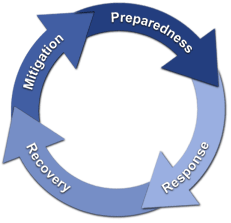The earthquake in Haiti and prior disasters in low-income countries reveal that disasters affect nations differently based on the level of development in the country. Risk reduction strategies and emergency preparedness planning can help mitigate the effects of a public health emergency on the local population. Public health emergencies and disasters occur within a cycle. In disaster-prone regions, governments, non-governmental organizations (NGOs), and the local population are always within one of the four phases of a disaster at all times: Preparedness, Response, Recovery, Mitigation.
Disaster Cycle

(Source: FEMA)
The primary problem for most low-income countries is that the government and local population already has a limited source of public health funds to spend on a large number of public health issues, and most countries do not have the fiscal capacity to devote scarce resources for disaster mitigation or preparedness. Therefore, disasters impact low-income countries disproportionately compared to the impact on high-income countries.
- Mitigation: High-income countries have building codes that regulate the physical structures in earthquake zones and allow these buildings to withstand strong earthquakes. Most low-income countries have limited or no building codes and regulations, and even simple and low-cost structural engineering interventions could save 1000's of lives in the event of an earthquake. In addition, many countries face challenges of corruption and bribery, and builders may use low-grade materials or bypass standards and regulations. In the May 2008 Sichuan Province 7.9 magnitude earthquake in China, many government buildings remained standing, but many schools toppled. This disparity raised concerns for different building standards between the two types of buildings.
- Preparedness: High-income countries have the capacity to equip and train emergency responders such as firefighters and paramedics. In addition, businesses often have contingency plans in the event of a disaster. Also, both government agencies and corporations can conduct drills to evaluate their preparedness and response capabilities and make modifications based on the findings from these drills. Low-income countries often have very limited pre-hospital care systems in place, and firefighting and search and rescue operations are frequently nominal throughout these nations.
When faced with daily public health challenges such as malnutrition, clean water availability, immunization campaigns, and communicable diseases treatment, low-income countries cannot afford to spend limited funds on disaster mitigation or preparedness. The international community must recognize that development assistance will need to focus on disaster preparedness disparities to prevent another devastating event such as the one that has occurred this past week in Haiti.



No comments:
Post a Comment